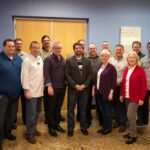|
|

Nick McKeown presented for Barefoot Networks at NFD14 |

This video is part of the appearance, “Barefoot Networks Presents at Networking Field Day 14“. It was recorded as part of Networking Field Day 14 at 13:00 - 15:00 on January 18, 2017.
Watch on YouTube
Watch on Vimeo
Nick McKeown, Co-Founder and Chief Scientist at Barefoot Networks, presented on the need for a programmable forwarding plane in the context of network switches. He highlighted the slow development time and fixed functions in silicon as significant drawbacks of current network switches. McKeown drew parallels between the evolution of domain-specific processors in other fields, such as Java and OpenCL, and the potential for similar advancements in networking through programmable switches. Barefoot Networks’ solution to this problem is Tofino, a P4 programmable network switch, which McKeown believes represents the next step in the evolution of network processing.
McKeown explained the inefficiencies of the traditional fixed-function switch model, using the example of VxLAN, a feature that took four years to be implemented in merchant switching silicon. He described the cumbersome process involving multiple teams and stages, from defining the feature to updating the ASIC, which ultimately delays the deployment of new functionalities. This slow pace is at odds with the rapid advancements seen in other tech sectors. McKeown argued that the current model, where features are defined by chip designers and fixed at design time, limits the flexibility and responsiveness of network systems. Barefoot Networks aims to overturn this model by introducing a programmable switch that allows users to define packet processing behavior through a high-level language like P4, which can then be compiled and executed on the switch.
The presentation emphasized the practical benefits of a programmable forwarding plane, particularly in terms of visibility and telemetry. McKeown recounted a scenario where traditional network measurement tools like ping and traceroute were inadequate for diagnosing network issues, highlighting the need for more sophisticated tools. With Tofino and P4, users can gain detailed insights into packet paths, rule matches, queue delays, and queue sharing, all at full line rate without generating extra packets. This level of visibility can significantly enhance network management and troubleshooting. McKeown concluded by addressing potential concerns about the market size and the need for configuration management, asserting that the programmability offered by Tofino aligns with existing firmware and software upgrade practices and is supported by a viable market size, particularly in large data centers.
Personnel: Nick McKeown









